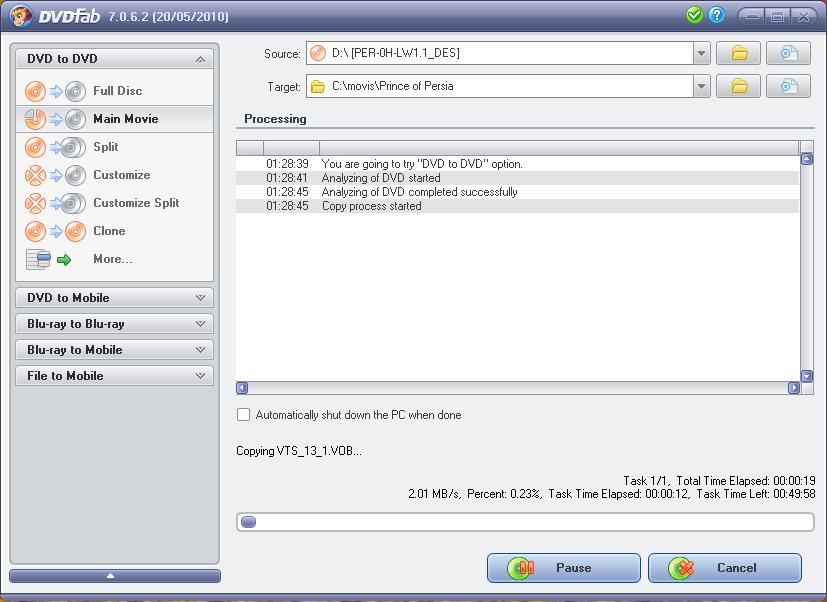

Computers that have DMA channels can transfer data to and from devices much more quickly than computers without a DMA channel can.Įven if your device whas set to DMA mode – it can revert to PIO (Programmed Input/Output) mode. It’s short for Direct Memory Access, a technique for transferring data from main memory to a device without passing it through the CPU. In this first window – select the language that is going to be used during the installation of the program.Ĭlick on the button ‘Finish’ and you are done with your installation and are ready to use the program. Rebuilt as E8Am #1436-1437 (order #7507) between June-August, 1953.The latest version of DVDFab Decrypter can be downloaded from .ĭuring the setup, please follow the instructions on the display. It later became Gulf, Mobile & Ohio #1200 retired in 1956 and now preserved at the Museum Of Transportation in St. It was transferred to the Alton Railroad's "Abraham Lincoln" service in April, 1936. This 1,800 horsepower boxcab was first assigned to the New York-Washington, D.C.

General Electric installed all electrical equipment and carried out testing at its Erie, Pennsylvania plant.Īcquired 3/1955: Ex-Elgin, Joliet & Eastern #700A-701A: Nee-Demonstrators #6001A, #6001A1.Īcquired 3/1955: Ex-Elgin, Joliet & Eastern #700B-701B: Nee-Demonstrators #6001B, #6001B1.Ĩ65x, 851x, 853x-861x (Odds), 867x-871x (Odds), 867Ax-871Ax (Odds)īuilt as Chesapeake & Ohio #5555, later became C&O #2219.īaltimore & Ohio Chicago Terminal.Ingersoll-Rand supplied the engine from its Phillipsburg, New Jersey plant, and was responsible for sales.Alco carried out mechanical work at its Schenectady, New York plant.The boxcab employed 300 horsepower and could produce 7,900 pounds of tractive effort at 10.0 mph. * A joint GE/Alco/Ingersoll-Rand project. You could find Baldwins, FMs, and Alcos in yard work while the B&O even tried out a few of the latter's dual-service cab model, the FPA-2.Īfter the War Production Board eased restrictions on buying new diesels during World War II, the B&O picked up its efforts to fully dieselize its locomotive fleet in the late 1940s.ĭuring the 1950s the Baltimore & Ohio purchased large batches of GP units, like the GP7, and even tried out Baldwin's unique AS616 road-switcher. From this point forward the railroad was a loyal EMD customer although did experiment with some models from other builders. They went to work on the flagship Capitol Limited that year and the B&O was quite pleased with the units. The cab units featured a beautiful sweeping carbody with a slanted nose. The railroad came back to Electro-Motive in 1937 for the streamlined variants of these boxcabs known as the EA model.
#DVDFAB DECYRPTER PATCH#
It tested on Sand Patch and spent time pulling the Royal Blue between Washington and New York before being transferred to Abraham Lincoln on subsidiary Alton Railroad. Then, in 1935 the railroad acquired Electro-Motive's early boxcab design for main line service, an 1,800 horsepower testbed unit numbered 50. That year it acquired a 60-ton, 300 horsepower boxcab produced by American Locomotive/General Electric/Ingersoll-Rand to carry out switching chores along its confined yard at 26th Street in New York City, situated on Manhattan's West Side. This enthusiasm continued into the diesel era as the railroad operated a variety of locomotives, ranging from Electro-Motive's very early EA passenger model to Baldwin's RF16 and Alco's stylish FA freight units.

The final new locomotives to wear any kind of "B&O" markings were a batch of SD50's that rolled of La Grange in 1984 wearing the Chessie System livery.įrom a historical perspective the B&O had been fascinating line to railfan dating back to the late steam era with big 2-8-8-4 EM-1's and 2-10-2 "Big Sixes" working Sand Patch, and 4-8-2's hustling fast freights through the Midwest. The C&O was a very healthy company and its infusion of cash enabled the B&O to purchase large batches of second-generation power such as GP30's, GP35's, GP38's, GP40's, GP40-2's, and more. That all changed with the Chesapeake & Ohio's acquisition in early February of 1963. Due to severe financial constraints by the 1950s, the railroad went nearly ten years without acquiring new locomotives. However, by the 1950s it was largely a loyal Electro-Motive customer, purchasing large batches of first-generation cab and GP units. The Baltimore & Ohio's diesel locomotive roster was initially an eclectic array of road-switcher models from all of the major builders, except General Electric (the railroad did own a few GE switchers).


 0 kommentar(er)
0 kommentar(er)
